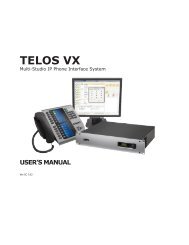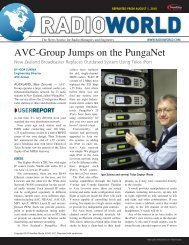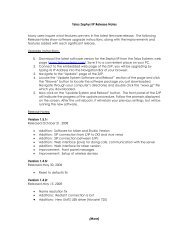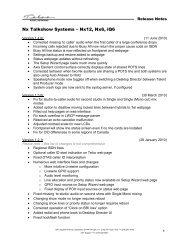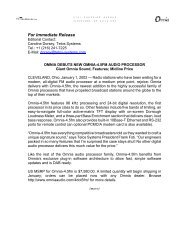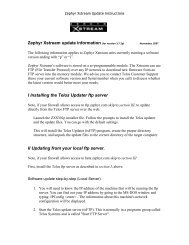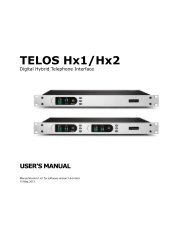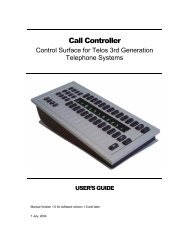NOW! 12-13 - Telos
NOW! 12-13 - Telos
NOW! 12-13 - Telos
Create successful ePaper yourself
Turn your PDF publications into a flip-book with our unique Google optimized e-Paper software.
TELOS | BROADCAST PHONE SYSTEMS | TECHNOLOGY ARTICLE<br />
8<br />
FOUR STEPS TO THE BEST PHONE CALLS EVER<br />
GETTING THE MOST FROM NEW PHONE TECHNOLOGY<br />
One hundred thirty-six years ago, Alexander Graham Bell<br />
spoke the famous sentence "Mr. Watson—Come here—I want<br />
to see you". Chances are good that you’re still using that same<br />
technology today when you put phone callers on-air.<br />
Broadcasters have used Plain Old Telephone Service (“POTS”)<br />
for some or all of the talk path from listener/callers or interviewees<br />
to the studio. We’ve used POTS for breaking news reports<br />
as well as sports coverage and for remote or “outside”<br />
broadcasts. As the least-common-denominator technology,<br />
POTS is still the technical glue that connects newer digital<br />
services together, often at the broadcast studios. And, while<br />
ISDN gave us a digital audio path to the local telco switch,<br />
we’ve had no chance to upgrade the audio codecs employed<br />
in ISDN telephony, as ISDN was a direct, functional replacement<br />
for analog POTS. Moreover, ISDN - like POTS - is a circuitswitched<br />
technology with the attendant limitations and expenses<br />
that become anomalous in today’s packet-switched,<br />
Internet-centric age.<br />
As limited in quality as POTS may be today, it’s still better<br />
than Mr. Bell’s early work with analog telephony. The same is<br />
true with Voice over IP (“VoIP”). Early efforts suffered from a<br />
nascent, slower Internet, competing and incompatible stan-<br />
dards, and very low bitrate codecs that didn’t sound good.<br />
Today VoIP has grown up to be the world-class telephony<br />
player. And VoIP over Session Initiation Protocol (“SIP”) is the<br />
standard with which old telcos, new providers, and end users<br />
are all connecting. SIP is the protocol that we broadcast engi-<br />
neers will be getting familiar with, too.<br />
WHY VoIP FOR BROADCAST?<br />
VoIP has already taken the business world by storm, increas-<br />
ing the lexibility of ofice phone systems and PBXs while si-<br />
multaneously lowering maintenance and equipment costs. In<br />
fact, most Fortune 500 companies have replaced their older<br />
PBX systems with VoIP for just these reasons.<br />
VoIP is a natural for broadcasters as well, interconnecting<br />
the phone system with audio interfaces, phone sets, console<br />
controllers, and PCs running screening software by way of<br />
eficient, low-cost Ethernet. Using VoIP, you can inally share<br />
phone lines among multiple studios and route caller audio<br />
anywhere in your facility, easily and instantly. Got a hot talk-<br />
show that suddenly needs more lines in a certain studio? Just<br />
a few keystrokes at a computer and you’re ready — no delays,<br />
and no cables to pull. A VoIP talkshow system can even connect<br />
with your business ofice’s VoIP PBX to allow easy call transfers.<br />
But VoIP from <strong>Telos</strong> isn't just business-class VoIP; it's tailored<br />
to the requirements of broadcasters. Every incoming line<br />
has its own ifth-generation <strong>Telos</strong> Digital Hybrid, our most ad-<br />
vanced ever — packed full of technology engineered to extract<br />
the cleanest, clearest caller audio from any phone line, even<br />
noisy cellular calls. Multiple lines can be conferenced with su-<br />
perior clarity and idelity. Smart AGC ensures truly consistent<br />
caller audio levels. New Acoustic Echo Cancellation from FhG<br />
removes feedback and echo in open-speaker studio situa-<br />
tions. And should you choose to use SIP Trunking telco ser-<br />
vices, calls from mobile handsets with SIP clients will beneit<br />
from VX’s native support of the G.722 codec, instantly im-<br />
proving caller speech quality. The quality of nearly all calls is<br />
improved, too, thanks to less transcoding and no 4-wire to<br />
2-wire (digital to POTS) transitions.



